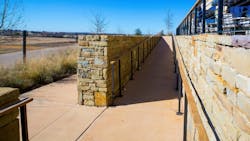Building for Accessibility: Railing Systems that Prioritize Inclusivity
Railing systems are an essential element of any building, providing safety, support, and guidance to occupants. However, railings can do more than just provide physical assistance—they can also promote a sense of inclusivity for individuals from all walks of life.
As such, ensuring your next project incorporates the right railing systems is not only important for ADA compliance, but also critical for making the structure accessible and welcoming to everyone. Keep reading as we explore some of the most important factors to consider for modern commercial railing systems.
ADA Compliance and Railing Systems
The Americans with Disabilities Act (ADA) establishes design standards to ensure equal access to public spaces and facilities for individuals with disabilities. When it comes to railing systems, the ADA outlines specific requirements regarding height, grip and placement.
- Height: Railings must be between 34 to 38 inches above the walking surface. This range allows individuals of various heights to find a comfortable and secure grip.
- Grip: The shape must be easy to grasp and accommodate different hand sizes. Round, oval or D-shaped rails are often recommended.
- Placement: Railings must be continuous along ramps, stairs and elevated surfaces. Interruptions or gaps in the railing system can present a hazard to individuals who rely on them for support.
By ensuring that the correct specifications are addressed prior to installing a commercial railing system, building owners can help avoid costly rework scenarios to bring their facility into ADA compliance.
Railing Systems for Accessibility
When discussing railing systems for commercial buildings, people immediately think of staircase railings and balcony railings. However, there are actually numerous types of railing systems that can enhance the functionality of your structure and promote accessibility and inclusivity in your building design.
- Handrails: Handrails along corridors, walls and ramps provide support and guidance for individuals with mobility challenges.
- Guardrails: These railings prevent falls from elevated surfaces such as balconies, mezzanines and platforms.
- Stair railings: Railings on both sides of stairs offer additional support and stability when ascending or descending, in addition to protecting walkers from going over the edge.
- Grab bars: These horizontal or diagonal bars in restrooms, showers and other high-risk areas provide additional support and balance.
By considering the various forms that commercial railings can take, building owners can ensure optimal comfort and functionality for all patrons.
Accessible Railings for Specific Needs
Depending on the type of building that you operate, it is important to consider the guests who are likely to frequent your facility. Different populations and specific needs will benefit from thoughtful railing design.
- Children and the elderly: Consider lower railings for children and higher railings in combination with handrails for the elderly.
- Visually impaired: Railings with contrasting colors or textures can help visually impaired individuals better perceive their surroundings.
- Individuals with cognitive disabilities: Simple and intuitive railing designs can provide clarity and ease of navigation.
Understand that these are just a few of the many diverse populations that are likely to visit your building, so be mindful of choosing the best railing systems to accommodate as diverse a demographic as possible.
Railing Materials and Design
The right railing materials and design can contribute to the durability, functionality, and aesthetics of your railing system. Here are some factors to consider:
- Durability: Choose materials that are resistant to corrosion, wear and tear. Stainless steel, aluminum and powder-coated metals are popular choices for both interior and exterior applications. Durable materials can lower repair costs and reduce the lifetime cost of ownership for a railing system.
- Design: Consider the overall design of your building and choose railings that complement the architecture. Contemporary, traditional or minimalist designs are available to suit different tastes. Glass railings are becoming increasingly popular because they work well with many modern designs and help promote the flow of natural sunlight to create a brighter, more inviting ambiance.
- Installation: Railing systems should be installed by qualified professionals to ensure proper anchoring and stability.
- Maintenance: Regular maintenance is crucial to ensuring the safety and longevity of your railing system. Inspect railings for any signs of damage or wear and take prompt action to address any issues.
By choosing the right railing materials and designs, buildings can ensure the seamless blend of form and function to guarantee a structure that is not only safe and accessible, but aesthetically stunning as well.
Choose the Best Railing Systems for Accessibility and Inclusivity
Railing systems are more than just safety features; they play a vital role in creating an inclusive and accessible environment.
“Railing systems that prioritize inclusivity are not just structures; they're pathways to equality and accessibility,” says Briana Dubois of VIVA Railings. “At the heart of design should be the commitment to creating spaces that everyone can navigate with dignity and ease. Inclusivity is not an option; it’s the foundation upon which we build a more accessible and interconnected world.”
By incorporating the right railing systems into your building design from the start, you can promote inclusivity, adhere to ADA guidelines and provide a safe and comfortable experience for everyone who visits or works in your building.
About the Author
Briana Dubois
Briana Dubois, a Technical Architect with a B.S. in Architecture from Texas A&M, specializes in architectural design and design consultations. Her innovative approach blends creativity with technical precision, ensuring seamless integration of form and function. With a commitment to excellence, Briana brings a unique skill set to each project, exceeding evolving industry standards. Her dedication to staying current with trends makes her a standout professional in the architectural realm.
